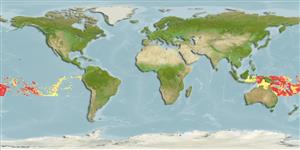Environment: milieu / climate zone / depth range / distribution range
Ecologia
marinhas; Água doce; estuarina demersal; catádromo (Ref. 51243); intervalo de profundidade 0 - 3000 m (Ref. 86942). Tropical; 1°S - 25°S
Pacific Ocean: Sulawesi, Indonesia to the Society Islands. Also recorded from Pitcairn (Ref. 9828).
Tamanho / Peso / Idade
Maturity: Lm ? range ? - ? cm
Max length : 100.0 cm TL macho/indeterminado; (Ref. 9828); 165.0 cm SL (female); peso máx. publicado: 0.00 g
Vértebras: 110 - 114. The only species that can be either variegated or plain-colored. Mottled individuals most closely resemble Anguilla celebensis and A. interioris in having broad, undivided tooth bands, but their ranges do not overlap. Plain-colored individuals most closely resemble A. japonica and A. borneensis, but those species both geographically distant. A. obscura is also plain-colored but has a shorter dorsal fin (Ref. 9828). The skin is grey to yellowish and more or less spotted with brown or black. It can be sometimes uniformly brownish red on the flanks and the back. The belly is white. Young specimens are grey and do not have spots (Ref.48622).
Found in rocky pools, often in coastal streams (Ref. 2847). No separate statistics available (Ref. 9828). The maximum weight (9,000 g) refers to the length (165 cm TL) of a female individual (Ref. 48622).
Ciclo de vida ou comportamento de acasalamento
Maturities | Reprodução | Spawnings | Egg(s) | Fecundities | Larvas
Smith, D.G., 1999. Anguillidae. Freshwater eels. p. 1630-1636. In K.E. Carpenter and V.H. Niem (eds.) FAO species identification guide for fishery purposes. The living marine resources of the WCP. Vol. 3. Batoid fishes, chimaeras and bony fishes part 1 (Elopidae to Linophrynidae). FAO, Rome. (Ref. 9828)
Status na Lista Vermelha da UICN (Ref. 130435)
Ameaça para os humanos
Harmless
Uso pelos humanos
Pescarias: espécies comerciais
Ferramentas
Relatórios especiais
Baixar XML
Fontes da internet
Estimates based on models
Preferred temperature (Ref.
123201): 3.7 - 9.6, mean 4.9 °C (based on 415 cells).
Índice de diversidade filogenética (Ref.
82804): PD
50 = 0.5000 [Uniqueness, from 0.5 = low to 2.0 = high].
Bayesian length-weight: a=0.00076 (0.00037 - 0.00155), b=3.17 (3.00 - 3.34), in cm total length, based on LWR estimates for this Genus-body shape (Ref.
93245).
Nível Trófico (Ref.
69278): 3.8 ±0.7 se; based on size and trophs of closest relatives
Resiliência (Ref.
120179): Muito baixo(a), tempo mínimo de duplicação da população maior que 14 anos (Preliminary K or Fecundity.).
Fishing Vulnerability (Ref.
59153): Very high vulnerability (90 of 100).
